|
Transportation as Media: The
Epistemology of Train Culture
|
![Wonderful
California [1916]](../Railroad%20Website/Aaron/Aaron/Scllo0007-a.jpg)
A pictorial guide to California circa
1916
|
This webpage and
digital archive of fifteen artifacts display
the California History Research Seminar
(History 279) class research with
the John
Lloyd-Butler Railroadiana Collection
during the spring of 2008. Their
research demonstrates an ideal of railroad
transportation as a “spatial concept.”
More specifically, this “spatial concept”
perceives the railcar not only as a means of
transportation but a cultural space unto
itself.
It is important to
note railroad culture as a whole in terms of
two distinct spheres: Life outside the
railroad institution versus life inside
it. More specifically, one side of this
theme involves the “outside” impact of the
railroad on surrounding communities in
California as well as their disappearance
after the decline of the railroad. The
other side investigates the “inner”
presentation of the railroad and how companies
advertised their trains as spaces of comfort,
safety and luxury, even after the rise of the
automobile which consequently lead to the
railroad’s decreasing popularity. |
|
Transportation
as Media: The Epistemology of Train
Culture
To view and learn more about the actual
documents, click on an image or linked text.
Titles and student names are links to their
documents.
View all the documents and their
descriptions in the
Digital Archive.
|
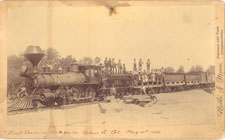
First train in
Porterville, Tulare, 1888
|
Life
Outside the Cars
The
railroad was instrumental in shaping
California. It changed the landscape of the
state in bringing in new towns and cities,
while killing others that were not along
their lines. It brought people to the state
to view its many wonders, such as Yosemite,
which were made readily available to
tourists by these same railroads. The speed
of the trains changed the way people viewed
the state in terms of travel. Travel across
the state was considered a trip of a few
days instead of weeks. This further changed
the landscape of California, especially when
looking at an early map of the state. Most
towns are along the lines, and these all
prosper even to this day. Life outside the
cars of the train was drastically changed
when the iron horse came to
California. --Aaron Stanton
Return to Top
|
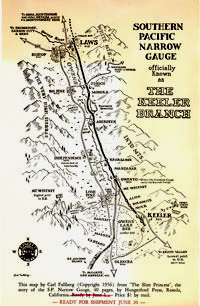
Keeler Branch, 1951
|
Dots on a Map: The
Rise and Fall of Railroad Towns
The three documents
that I selected for inclusion in
this database are maps that I found
particularly interesting due to their age
and their representation of California in
the days when the railroad ruled. One
map is a 1950s pictorial map of the Southern
Pacific Keeler Branch, a narrow-gauge
railroad in the Owens Valley. The
other two are large fold-out maps from the
late nineteenth century—one of the Union
Pacific’s routes in the Pacific and Rocky
Mountain states, and one of the Southern
Pacific and its routes in the Pacific and
Southwest. These maps are part
of the basis for my research project of the
same name, which uses several towns as case
studies to divine the effect of the railroad
on growth (and decay) of towns.
--Charles Bennett
Return to Top
|
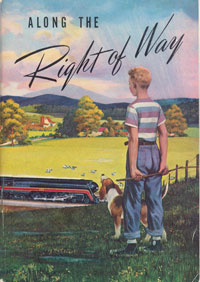
Along the Right of Way
guide to towns, circa 1950s
|
A Descriptive Look on
Railroad Rhetoric and Propaganda
Throughout the latter half of the twentieth
century, a collective mass effort in order
to revitalize the railroad institution had
been implemented to combat the then recent
successes of the automobile industry. Many
railroad companies subsequently advertised
themselves to a sought after loyal populace
through many distinct forms of media.
Portrayal of railroad transportation through
this media
gives an interesting view on corporate
visions of advertising campaigns as well as
propaganda techniques. These propaganda
techniques emphasized the promotion of many
central spatial ideals characteristic of
railroads over the automobile. Moreover, the
conjunction of railroad self-advertising
with this theme of a spatial sphere inside
the railcar gives an impression for the
luxury, comfort, and reliability of a long
standing institution. This sphere inside the
railcar was promoted as comfortable and
luxurious to attract prospective customers
to a classy alternative from the average
automobile lifestyle. The media also
manifested a reliable vision of railway
travel as withstanding the test of time to
be held as an enduring institution. --
Daniel Drugan
Return to Top
|
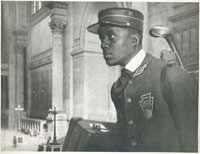
Photo from Broadway
Limited 1902-1927
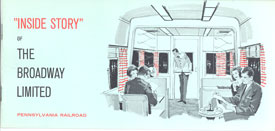
"Inside Story" of the Broadway
Limited circa 1961
View all the documents in
the Digital
Archive.
|
Getting to
Know George: An Analysis of the African
Americans' Contributions to the
Railroad
In order to keep up
the image of luxury, safety, comfort,
and quality service associated with
their trains, railroad corporations
depended heavily upon their porters and
dining car waiters to provide kind and
courteous assistance to passengers.
These exclusively Black servicemen who
occupied the train’s "inner" community
represented the face of railcar service
and thus were put under heavy pressure.
Specifically, they were required to
follow strict guidelines posted in
detailed rule
books while using their own quick
wits and judgment. Moreover there
existed a clear status and racial divide
between the upper and middle-class White
customers and the struggling
middle-class Black servers who were
expected to conform to this division.
Despite the stress and degradation,
Black porters and dining car servers
continued to diligently serve passengers
for decades and though the face of the
railcar serviceman has been blurred and
transformed over the years, it is vital
to recognize and remember who originally
established that image of luxury,
safety, comfort, and quality service.
--Lauren Watanabe
Return to Top
|
About
this Project / Acknowledgements
Occidental
College's "Transportation as Media" Research
Seminar was developed by Dr. Jeremiah B.C.
Axelrod, Adjunct Assistant Professor of
History and made possible through a grant by
the Pacific Railroad Society. The library
project is developed in collaboration with
the Special Collections Department:
Dale Ann Stieber, Special Collections
Librarian, and Ashlie Mildfelt, Cataloging
Assistant, with student staff Chris Jackson
and Sarah Hunt. |
The John
Lloyd-Butler Railroadiana Collection
John
Lloyd-Butler, a rancher from Saticoy,
California, took an interest in American
railroading, but was never able to devote
himself to the hobby until he retired from
ranching. He and his wife spent the last ten
years of his life traveling the American
railroads and collecting whatever he could
on the subject. The result is the John
Lloyd-Butler Railroadiana Collections
covering the history and development of the
American Railroad from 1846 to the early
1970's. Lloyd-Butler donated his collection
to Occidental College in 1972. Throughout
the years, the collection has expanded to
include titles from other rail fans
including, Oxy alumni, David Kearns Todd,
and Carlton E. Byrne. Currently, the
collection contains over a thousand
published books, rare government reports,
railroad periodicals, and ephemeral
materials, including time-tables,
advertising brochures, postcards, and
tickets.
|
Page last edited by on
03/06/2013.
Occidental
College Library Special Collections & College Archives
© 2008 Occidental
College
|